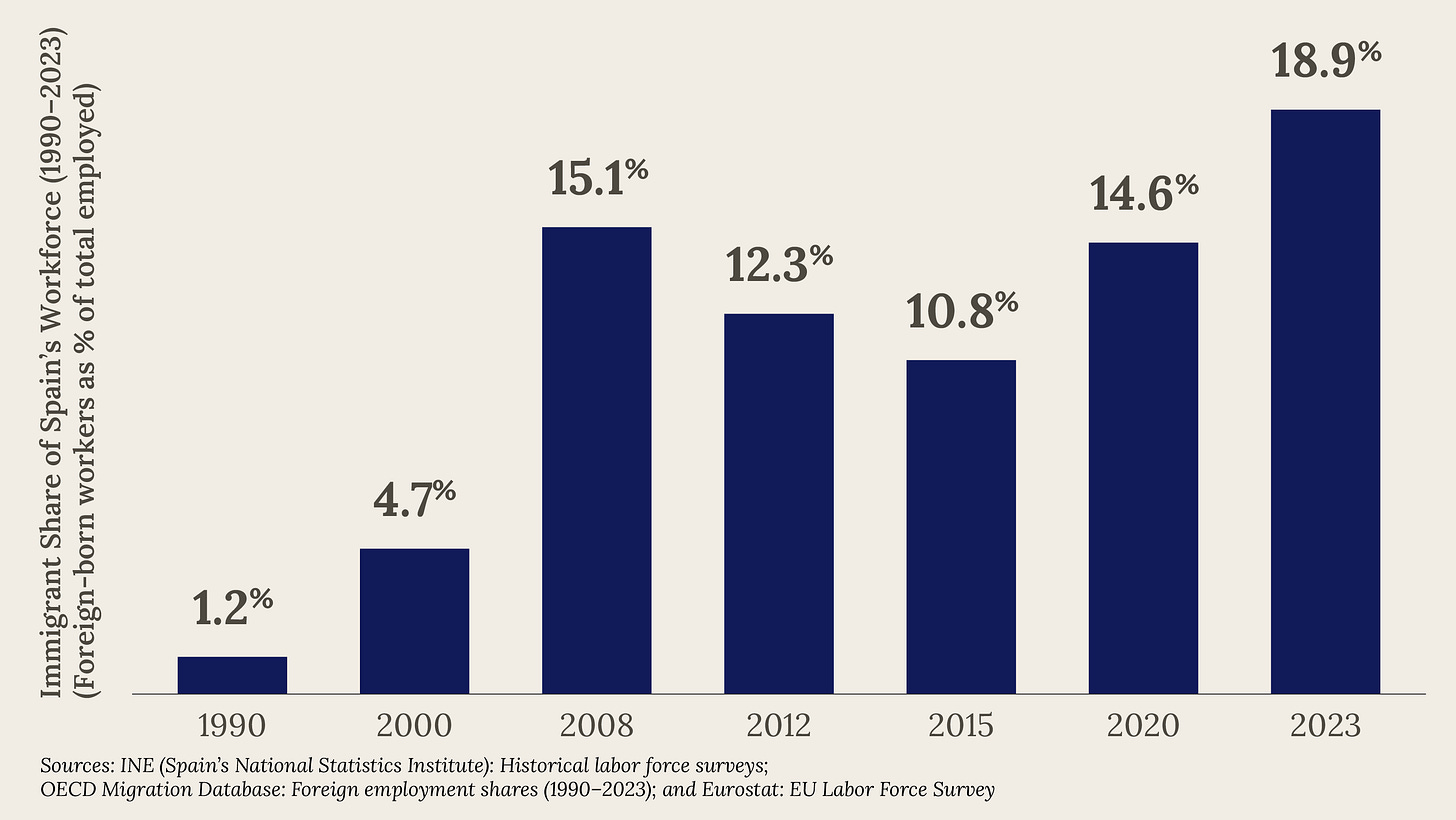How Spain’s labour and immigration policies have fuelled an economic boom
Spain’s economic boom proves it: smart immigration policies and labour reforms aren’t just progressive—they’re profitable.
Recently, I read a great article by Maria Ramirez, a journalist and deputy editor of Spanish news outlet elDiario.es – “Why is Spain’s economy booming? Thanks to migration – which proves xenophobia doesn’t pay”
In her article, she highlights how, over the past decade, Spain has transformed from a poster child of Europe’s post-2008 economic malaise into one of its fastest-growing economies.
While tourism and exports often steal the spotlight, the country’s resurgence owes much to bold labour market reforms and pragmatic immigration policies. These strategies have not only addressed structural weaknesses but also unlocked new growth sources.
Critically, it offers lessons for nations like the UK and others who are also grappling with ageing populations, labour shortages, and inequality.
How has Spain made this work? Looking at the evidence, there seems to be two key factors – and I set out how (together) they’ve made a huge economic impact.
Labour market overhaul: flexibility meets worker protections
Spain’s pre-2012 labour market was notoriously rigid, characterized by a dual system of permanent workers (with strong protections) and temporary workers (with little job security).
This dichotomy stifled productivity, discouraged hiring, and left young people disproportionately unemployed. At the height of the Eurozone crisis, Spain’s unemployment rate soared to 26%.
The previous conservative Government’s 2012 reforms introduced measures to reduce dismissal costs for permanent contracts and promote flexibility. While controversial, these reforms gradually reduced temporary work from 33% of employment in 2012 to 18% by 2023.
In 2021, Spain’s socialist-led coalition government introduced changes that reversed some aspects of the conservative reforms - strengthening collective bargaining and limiting precarious gig-economy contracts (e.g., in delivery services).
This hybrid model has, arguably, balanced flexibility with worker rights, stabilizing employment.
As a result, unemployment fell to a 15-year low of just over 10% by the end of 2024, with youth unemployment more than having from 55% to 25%. At the same time, labour productivity grew by 1.2% annually since 2019, outpacing the EU average.
The role of immigration in boosting growth
Spain’s ageing population and low birth rate threatened long-term economic sustainability. However, by 2024, immigrants constituted nearly 19% of the population (up from 6% in 2000), injecting vitality into many of Spain’s key economic sectors.
This did not happen by accident. Spain has taken an intentional approach – bucking the demonisation of immigrants and immigration (if you exclude some of the noise from right-wing parties such as Vox).
Firstly, it has put many immigrants on a sounder footing within the economy through its regularization programs. This has been done every so often, notably in 2005 and 2021, granting legal status to those contributing to the economy. Critically, this also reduced exploitation and increased tax contributions.
Secondly, Spain has introduced sector-specific visas for agriculture, healthcare, and tourism – addressing acute labour shortages in those sectors. For example, the 2022 “Agriculture Visa” attracted seasonal workers from Latin America and Morocco, sustaining Spain’s €50 billion agri-food sector.
And, finally, it has prioritised the integration of immigrants – enabling them to gain access to public healthcare and education, fostering social cohesion. Language programs and fast-track citizenship for Latin Americans has further eased integration.
All of this has made a big difference to Spain’s economy.
Immigrants contributed 50% of Spain’s GDP growth between 2000 and 2023, per OECD data. They now fill 80% of new jobs in hospitality and agriculture, sectors critical to Spain’s recovery.
The agri-boom in the Almería province provides a good example of how these pro-immigration policies have affected local economies.
The province, once arid and impoverished, is now Europe’s “vegetable garden,” producing 3.5 million tons of produce annually. This miracle was powered by migrant labour. Over 40,000 Moroccan and Sub-Saharan African workers plant and harvest crops, often under regulated seasonal visas. Also, cooperative farms are major players in the local economy, with workers being provided fair wages and housing. And, in a sector infamous for high labour turnover, these co-op’s have a good track record of retaining their teams.
Spain’s success is not without challenges. Inequality persists, and some sectors still rely on low-wage migrant labour. However, its policies offer a blueprint:
1. Flexicurity with fairness: Combining labour market flexibility with robust protections is important for both native and immigrant workers. Germany’s “mini-jobs” reform and Denmark’s flexicurity model show similar success.
2. Implementing proactive immigration integration: Regularization reduces shadow economies. Canada’s points-based system demonstrates how aligning immigration with economic needs is a key factor in driving growth.
3. Investing in social infrastructure: Spain’s healthcare and education access for migrants prevents ghettoization – something UK immigrants end up experiencing. Sweden’s language programs mirror this approach.
4. Designing sector-specific solutions: Tailoring policies to industries in need. Australia’s farm visas and Japan’s nursing visas are examples.
5. Collaborating regionally: Spain’s bilateral agreements with Morocco and Latin America has eased migration flows. The EU’s Blue Card program could expand this model.
Spain’s story refutes the zero-sum narrative that pits workers against migrants or flexibility against rights. By viewing labour and immigration as tools for renewal—not threats—the country turned demographic challenges into economic strengths. For nations facing similar hurdles, the lesson is clear: inclusive policies, adaptive labour markets, and a willingness to embrace global talent can ignite growth while fostering resilience.
As automation and climate change reshape economies, Spain’s pragmatic optimism offers a roadmap for turning turbulence into opportunity.





